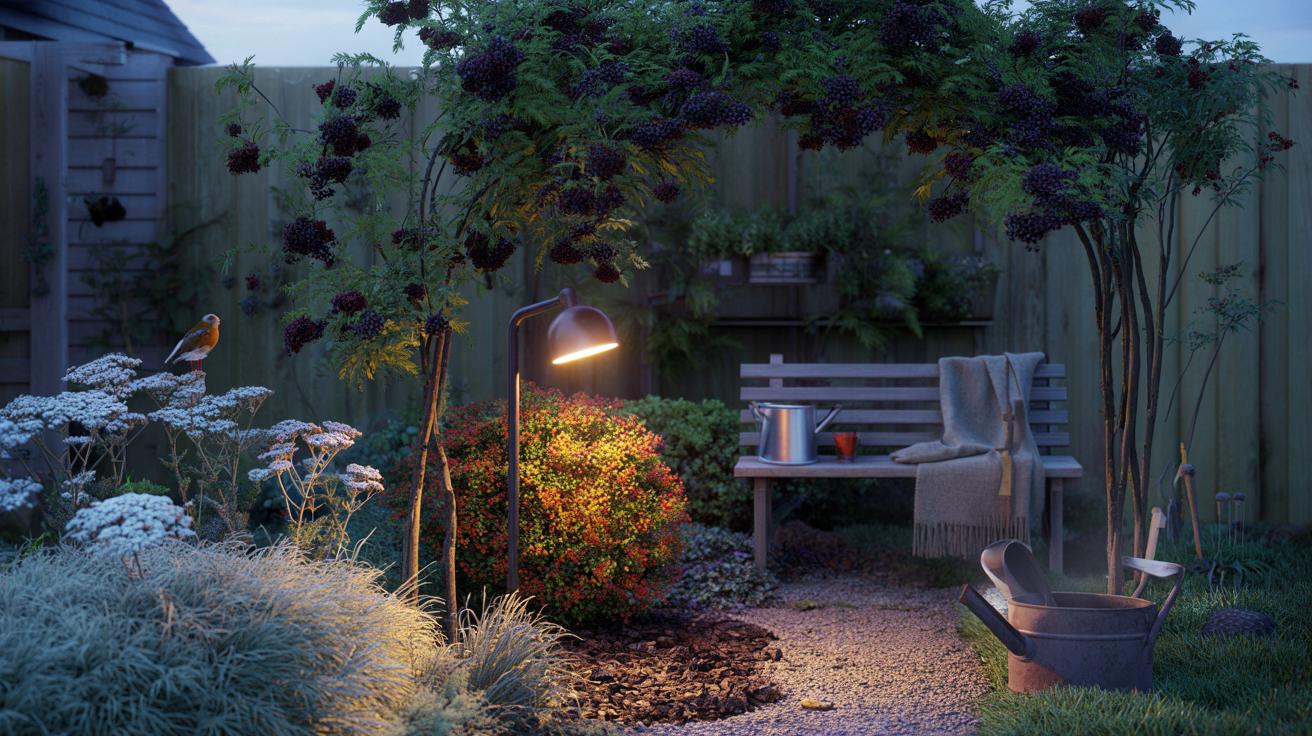Late October doesn’t have to mean dull borders and an empty patio. With three well-chosen plants, you can stage reliable colour, wildlife action and texture that hold their own right through frost. The trick lies in structure, berries and seed heads that glow in low light and invite you out with a mug and a jumper.
Why autumn gardens stall and how you can reset them
By mid-October, herbaceous borders sag, lawns silver with dew, and many perennials recede. Interest drops just as you crave somewhere calming to unwind after work. You don’t need a redesign. You need plants that shine when temperatures slide, that feed birds and that still look composed under a dusting of ice.
Choose plants that earn their keep from October to March: fruit for birds, bones for structure, and seed heads for theatre.
I trialled a simple trio: black elder for winter drama, yarrow for frosted lace, and a handful of berrying shrubs to punctuate paths and porches. The bill came under £35 for starter pots in a local nursery, and the planting took under 45 minutes with a hand fork and a trug.
Black elder: a wildlife magnet with winter drama
Black elder (Sambucus nigra) holds space when other shrubs fade. In autumn, its dark fruit clusters catch weak sunlight and stand out against pale turf and tawny foliage. Birds queue for the berries, and its branching gives gentle screening beside seating.
Where to site it and what it costs
Give it sun or light shade and a fresh, well-drained soil. Avoid waterlogged patches. Plant now while the ground stays workable and roots can settle before hard frost. Allow 1.5 to 2 metres around the shrub, so it can arch and frame a bench without crowding it. Expect to pay £12–£18 for a 2–3 litre pot.
Simple care that fits busy weeks
Prune out the oldest or damaged stems once a year to stimulate fresh growth. Add a 5–7 cm mulch of leafmould or shredded bark in late autumn to stabilise moisture and soften winter temperature swings. That’s enough to keep colour and fruit consistent.
Cook elderberries before eating; raw fruit can upset stomachs. Birds handle the crop safely and will clear much of it for you.
Yarrow: frosty lace that holds its shape
Yarrow (Achillea millefolium) reads like a fine fabric in cold light. Flat heads and feathery leaves catch hoar frost, adding movement when the border quietens. It pairs neatly with grasses, lavender and late asters for a gentle gradient of blush, straw and chalky yellow.
Planting notes that save you water
Space plants 30–45 cm apart in a sunny, well-drained strip. Add a small forkful of compost at planting, then leave the soil undisturbed. Cut stems back in late winter rather than autumn; dried heads become winter sculptures and shelter insects. Once established, yarrow needs little watering, even in lean ground.
Leave seed heads standing through winter. They sparkle at dawn and support beneficial insects when food is scarce.
Berry shrubs: bright beacons for short days
Berries are your brightest allies when days feel short. Cotoneaster, holly and pyracantha carry reds, oranges and golds that show even in fog. Place one by the front door, another near the terrace, and your eye always lands on colour as you pull on a coat.
Placement, pruning and practical warnings
Set shrubs where you pass daily: gate, path corner, or just beyond the kitchen window. Blend varieties for a longer show and varied berry size. Shape lightly after fruiting to keep tidy. Pyracantha carries serious thorns, so keep it back from narrow paths and children’s play zones. Many cotoneaster species spread by seed; choose garden-centre selections marked as non-invasive and deadhead where necessary.
Birds burn through calories in cold snaps. Berrying shrubs turn your garden into a dependable service station for robins, thrushes and blackbirds.
The 45‑minute October plan
- Mark a sunny triangle: elder as the back anchor, yarrow toward the front, a berry shrub by the path.
- Dig holes twice the width of pots; plant level with the soil surface, not deeper.
- Water each plant with a full can to settle roots, even if rain is forecast.
- Mulch around, not against, stems to a depth of 5–7 cm to moderate winter swings.
- Leave spent stems and heads; tidy in late February when frosts ease.
- Add one nest box and a shallow water dish to make wildlife linger.
What you get for your money and time
| Plant | Height at 3 years | Spacing | Light | Soil moisture | Care minutes/month (winter) |
|---|---|---|---|---|---|
| Black elder | 1.8–2.5 m | 1.5–2.0 m | Sun to light shade | Fresh, not waterlogged | 10 |
| Yarrow | 0.4–0.6 m | 30–45 cm | Full sun | Well-drained, lean | 5 |
| Cotoneaster/holly/pyracantha | 1.0–2.0 m | 80–120 cm | Sun to light shade | Average | 8–12 |
Design tricks that make evenings feel longer
Position the elder to frame a seat and block a neighbour’s glare. Thread yarrow along the border edge so you brush past its fragrance. Place berry shrubs where low sun hits them at 3–4 pm; the fruit glows and lifts the mood when daylight fades. A single, low-voltage spike light trained through a berry-laden branch reads as candlelight without fuss.
If wind rattles the plot, tuck plants near a south- or west-facing wall for warmth. In heavy clay, lay a 3–5 cm grit layer in the planting hole to keep winter wet away from roots. In sandy soils, mulch thicker and water deeply once every fortnight until the first hard frost.
What to avoid and what to embrace
Skip sterile, high-maintenance bedding at this time of year. You’ll pay more and gain less. Choose structure and fruit that deliver for months. Handle pyracantha with thick gloves. Keep holly berries out of reach of small children. If you want edible elder, grow Sambucus nigra rather than ornamental purple-leaved forms, and cook the berries for cordial or jam.
Some cotoneasters self-seed into hedgerows. Pick compact named forms or prune after fruiting to reduce spread. If your elder sends up suckers, slice them cleanly at soil level in spring. These small checks hold the scheme together without heavy labour.
Extra ideas for restless hands and curious minds
Test your soil with a simple squeeze: if it forms a ribbon, add grit around yarrow; if it crumbles, add compost around elder. Try a 30-minute weekend refresh: brush leaves off paths, top up mulch by the bench, and swap a dull pot for a glazed one that mirrors berry colours. That quick reset resets your mood too.
Fancy a small experiment? Set a trail camera near the shrubs for seven nights and note visitors. Tally blackbirds at dusk, count robin visits on cold mornings, and watch how quickly berries disappear during frosty runs. You’ll see why these choices pull you outside, even when the breath hangs white and the kettle calls.








